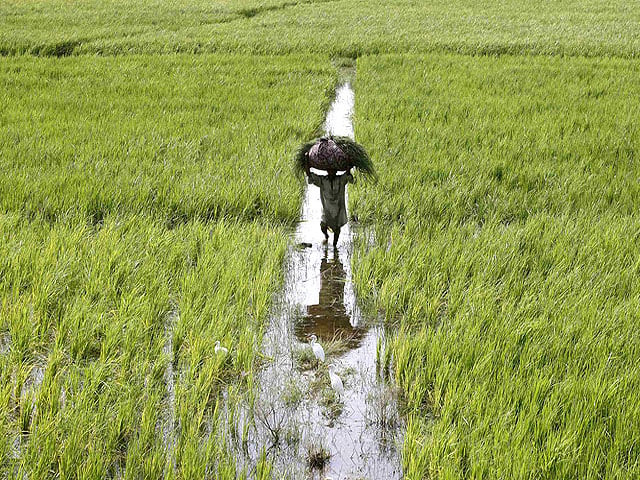Enabling policies for developing Pakistan’s agriculture
Report findings aim to overcome multiple constraints facing smallholders

In times of trouble and strife, whether because of the coronavirus or the tender mercies of the International Monetary Fund (IMF), it is useful to keep a longer term perspective. This enables us to look beyond the moment, to focus on the strengths and weaknesses of Pakistan, and hence to identify the most strategic actions to generate lasting change.
A recent report, jointly prepared by experts from Victoria University in Australia and leading government officials in Pakistan, takes such a strategic view. It identifies smallholder agriculture as a pivotal sector for Pakistan, arguing the comprehensive initiatives to assist smallholders could have major flow-on economic and social impacts.
The starting point is that while the global economy experienced a major economic transformation between 1990 and 2015, Pakistan’s economy remained basically isolated from this transformation. Pakistan’s economy still relies heavily on agriculture, which accounts for 19% of the country’s GDP.
Around 64% Pakistan’s population (212 million) lives in rural areas, most of who are employed directly or indirectly in agriculture. Small farms (of less than two hectares of farming area) dominate Pakistan’s agriculture. Due to the combination of high population growth rates and sub-division of family farms from one generation to the next, average size of family farms continues to decline sharply.
Thus, while small farms constituted 28% of all farms in 1972, their share had increased to 64.7% in 2010. Average farm size had fallen from one hectare in 1972 to 0.8 hectare in 2010 and the number of small farms had increased from 1.6 million to 5.35 million during this period.
The enabling policies discussed in this report are aimed at overcoming multiple constraints facing smallholders in Pakistan and increasing their productivity, marketable surplus, household incomes and living standards. Better designed credit policies, supported by farmer friendly extension services, modern technologies and scientific inputs have the potential of revolutionising Pakistan’s agriculture and rural economy.
These policies would break the economic and social isolation of small farmer households from the markets by opening up the mutually beneficial market-based relationships between small farmers and local businesses.
Analysis in this report shows that that major initiatives for transforming smallholder agriculture in Pakistan must be focused on the following areas; access to domestic and international markets must be improved; extension services for small farmers must be made more demand-based and small farmer friendly; use of research and development (R&D) based practices need to be made more focused on the needs of small farmers; access to formal credit for small farmers must be improved; promotion of various forms of rural producer organisations (e.g., co-operatives, self-help farmer groups) would also play an important enabling role in Pakistan’s rural transformation; and the role of women must be uplifted. Women already play a significant role in smallholder farming, but are neither empowered nor trained sufficiently to play their roles effectively.
There is urgent need for enhancing the policy focus on smallholders in general and on horticulture and livestock and dairy farming in particular, because of the dominance of small farmers in these segments of agriculture. At present, smallholder households have limited interactions with agricultural markets and local business enterprises. This report makes several recommendations to address the major constraints facing small farmers in Punjab and Sindh.
Maximum potential benefits of these recommendations would flow from the implementation of the entire package of reforms simultaneously, rather than selectively. This would maximise the impact of the reforms because progress on any one aspect of reforms (say, the easing of rural credit constraint) would also benefit from the other suggested reforms (eg higher gender balance or more demand-based extension services). The following outcomes would be achievable: higher output and productivity, with a direct increase in household incomes small farmers; higher household spending by small farmers on local goods and services, benefitting in turn local business activities for meeting expanding demand (eg for fodder, seeds, equipment); greater economic interaction between small farmer households, local markets, lending institutions, and agriculture-based business activities in adjacent small towns; and greater usage of, and reliance on, agricultural research and extension services, modernising over-time the subsistent smallholder agriculture into a vibrant and dynamic rural industry.
These outcomes would transform not only rural economy of Pakistan, but also support the growth of small towns and larger cities benefiting from new rejuvenation of rural economy.
Given the federal structure of Pakistan’s public sector, this transformation will need to be supported by both national and provincial level governments. It is important that enabling policies outlined in this report are treated as longer-term policies, tailored to different circumstances in different regions, with appropriate infrastructure support.
Their implementation should not be selective or on piece-meal basis; instead these policies should be implemented as integral parts of a broad-based reform across the various policy areas identified above. Strategic cooperation between the national government, provincial governments and local (village level) governments in this implementation would be highly beneficial.
In conclusion, smallholder agriculture in Pakistan is facing a multitude of challenges that are collectively holding down its performance far below its potential. Because small farmers are lacking in education and training in supplying to modern food markets, their productivity and household incomes remain low.
As a result, their agricultural practices remain outdated, rendering them unable to meet the demands of modern food markets. By following the recommendations of this report, central and provincial governments can help small farmers to overcome these challenges, integrate with modern food supply chains and become much more efficient and prosperous.
As stressed in the conclusion, the recommendation made in this report needs to be viewed as “long-term policies and not individual projects; tailored to different circumstances in different regions, with appropriate infrastructure support; and implemented in an integrated way across the various policy areas and with strategic cooperation between the national government and provincial governments.”
Bhajan Singh Grewal is a leading expert on fiscal federalism. He has authored more than ten books and numerous articles on policy-based development issues on public finances in India, Australia, China and Pakistan.
Dr Kashif Rashid holds a Masters and PhD in finance from Victoria University Melbourne, Australia. Currently, he is serving as Head of Management Sciences Department, COMSATS University Abbottabad.



















COMMENTS
Comments are moderated and generally will be posted if they are on-topic and not abusive.
For more information, please see our Comments FAQ